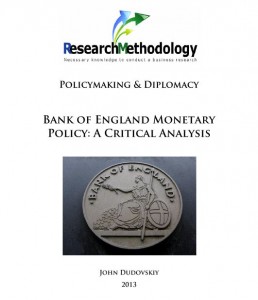Posts Tagged ‘Policymaking’

This paper represents a policy paper that contains a critical analysis of Bank of England monetary policy. The paper starts with reflecting upon the main principles of Monetary Policy Committee (MPC) practices. This is followed by discussions about the role of The Bank of England policies in maintaining macroeconomic stability in UK with the particular focus on MPC impact on the level of inflation, prices of assets, the level of exchange rate and unemployment rate. Moreover, the paper reflects upon a range of inefficiencies associated with MPC monetary policy practices and it also provides recommendations in terms of improving Bank of England monetary policy practices. The Bank of England was founded in 1694, it was nationalised in 1946, and gained its independence in 1997. The Bank is “committed to promoting and maintaining monetary and financial stability as its contribution to a healthy economy” (About the Bank, online, 2013) The Bank of England has two major purposes: monetary stability and financial stability. The Bank “acts as the government’s bank, regulates the money stock growth rate and the availability of credit, and serves as a banker’s bank for commercial banks, making loans and holding deposits” (Allen, 2009, p.29). Monetary Policy Committee (MPC) of The Bank of England deals with issues related to the monetary policy in UK. The members of MPC are appointed by The UK HM Treasury that also sets the inflation target. Monetary policy is best defined as “the actions of a central bank, currency board or other regulatory committee that determine the size and rate of growth of the money supply, which in turn affects interest rates” (Investopedia, 2013). Four main characteristics of monetary policy have been specified as goals, instruments, discretion, and intermediate targets (LaBonte and Makinen, 2006). Instruments are policy options available to central banks to control…

Multiple Stream Model developed by Kingdon (1984), on the basis of refining garbage can framework, represents an alternative approach to policy process and perceives it in terms of three different streams: a problem stream, policy stream to address the problem, and the political stream. According to this theoretical framework “the streams are usually independent, but windows of opportunity sometime open that allow for the streams to interact” (Crank, 2003, p.35). First, the problem stream relates to the source of the issue that necessitates introduction of a policy. As it has been partially discussed above, the problem stream for Tesco packaging policy is directly related to increasing status of sustainability issues in media, and consequently consumers in UK and elsewhere becoming more sensitive towards the issues related to sustainable development. Second, the policy stream involves evaluations and analysis of a wide range of policy ideas and proposals directed to the solution of the problem. In Tesco, the policy to be adopted as a response to the problem needed to balance the profitability of business operations with the creation of ‘green’ image fir the brand. In other words, Tesco strategic level management faced with the task of positioning the company as a ‘green’ in a cost effective manner. Third, the political stream includes various elements such as relevant government legislation, the influence of various non-government organisations and pressure groups and others. It is important to mention that while UK government encourages multinational business such as Tesco to behave in a socially responsible manner, there is a lack of legislation that specifies the extent of ‘greenness’ businesses need to adhere to (Horrigan, 2010). Therefore, Tesco possesses a great level of freedom in terms of government legislation when formulating its packaging policy. However, there are additional elements of political stream such as non-government organisations…
